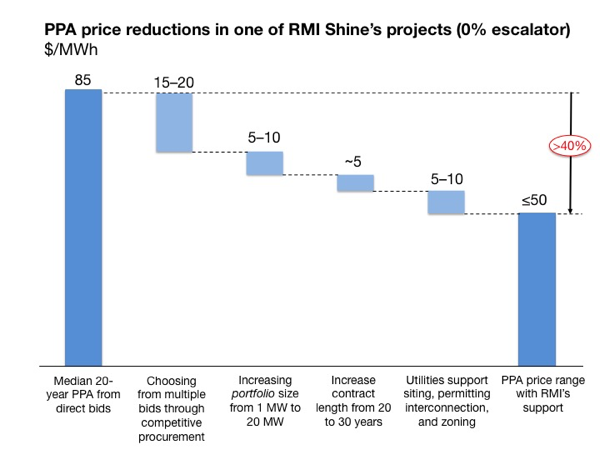solar photovoltaics panels in solar power station with mountains background

Solar Embrace
RMI Expands Community-Scale Solar Programs across the Nation
More than a year ago, Rocky Mountain Institute (RMI) announced its Shine Program would focus on community-scale solar. We claimed that community-scale solar could be procured at costs close to utility-scale solar, unlocking a 5–30 GW market by 2020. However, we could not have predicted the success of our initial projects. As RMI is enabling power purchase agreements (PPAs) at prices 40 percent below median bids, we are seeing increasing interest in community-scale solar, and we are expanding our efforts across the nation.
We define community-scale solar as 0.5 MW to 5 MW arrays connected to the distribution grid. Community-scale solar includes community solar, or shared solar, and also systems contracted by a single utility, city, or corporation.
Community-scale solar can be a particularly good fit for electric cooperatives and municipal utilities, organizations that may not have the energy demand for large, utility-scale systems. Such small utilities often operate electric grids in rural areas where community-scale solar can add particular value: reduce costs of energy, provide a hedge against rising fuel prices, defer grid investments, and meet member demand for renewables.
A few key strategies have enabled us to deliver PPAs at lower prices:
- Procure solar through a competitive procurement, rather than through a direct agreement with a solar developer. Writing a good request for proposals (RFP) and receiving bids from multiple vendors allows prospective buyers to pick the best price from a distribution of bids. This strategy can reduce PPA prices by 20 percent.
- Form a regional coalition of buyers. Increasing the volume of a portfolio will bring down costs, even when individual systems are “small” (i.e., <5 MW). A portfolio of solar arrays can reduce prices by 10 percent or more, even when individual arrays are just 1 MW. Our results show that economies of scale can be achieved even when individual solar arrays are small, as long as they’re bundled into a larger group. Group size matters more than individual project size. In many regions today, a 10 percent lower PPA price can move solar electricity from a premium product to one that saves customers money.
- Extend the contract length of PPAs. For good reasons, buyers may have concerns about signing long-term contracts. However, when buyers sign PPAs for the full lifetime of a solar array, the system owner’s risk of not collecting revenue for production in final years is reduced. Signing a long-term contract can thus further bring down the levelized price of electricity.
- Support developers with siting, interconnection, zoning, and permitting. A municipal government is better positioned to modify zoning regulations than an out-of-state commercial solar developer. Similarly, an electric cooperative that has insight into loads on its low-voltage grid can assess where solar PV can be interconnected without system upgrades, a task much harder for a commercial developer. When buyers play such strategic roles, they can cut costs by 10 percent to 15 percent.
Going forward, RMI’s Shine program will continue to disrupt the market and further reduce costs by testing new opportunities, including:
- Reduce financing costs. Aggregating utilities in solar procurement increases total capital deployed. This in turn enables more and different types of financing to be used, likely reducing costs of capital. In addition, utilities’ demonstrated creditworthiness can improve financing terms on both debt and (tax) equity. For example, utilities might prepay their PPAs, leveraging their lower cost of capital through credit lines or municipal bond issuance, which could reduce PPA prices around $10/MWh. Additional information on financing structures can be found in our recent report Financing Community-Scale Solar: How the Solar Financing Industry Can Meet $16 Billion in Investment Demand by 2020.
- Reduce costs of land through dual-use applications. Viable land-lease prices for solar PV on the distribution grid range from $400 to $5,000 per acre per year. Dual-use applications, such as installing solar canopies over parking lots or colocating agriculture and solar, could eliminate land costs, reducing installed costs by $1–5/MWh.
- Simplify the solar procurement process. Writing and running an RFP for solar procurement can be a complicated task, and lengthy PPA negotiations can be costly due to mounting legal fees. To simplify the process of buying solar PV, RMI has developed standard RFPs and standard PPAs to use in solar procurement around the nation, greatly simplifying and shortening the solar process.
- Increase pressure on solar developers to streamline system design. Today, most 1–5 MW solar PV systems are custom designed for a specific site. In addition, solar developers often incur tens of thousands of dollars of costs before a solar project receives “notice to proceed,” the point at which a site has been secured, interconnection has been approved, and zoning and permitting has been ironed out. We see a future of standardized 1 MW system design and deployment that eliminates all custom design and engineering, and allows developers to sell community-scale solar as a catalogue product, thereby greatly reducing installed costs. We are building a collective of solar developers who share this vision and want to take part in realizing it.
RMI’s Shine program is supporting about 100 MW of ongoing projects in New Mexico, New York, and Colorado, and exploring new projects in the South and Southeast, including Texas and North Carolina. This work brings us well toward reaching our goal of directly supporting 1 GW of new community-scale solar systems by 2020. Over the next few years, the program will focus on continuing to scale our efforts all around the nation.
We are excited to deliver the powerful benefits of solar energy to a growing number of customers who previously could not access them. If you lead a utility, city, or corporation and want to learn more about how community-scale solar could help you reach your economic goals, please write to shine@rmi.org.
Image courtesy of iStock.
